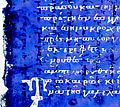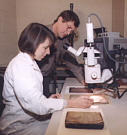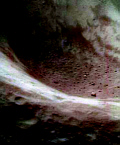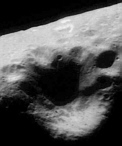
|
High-tech tools reveal the
perpendicular underlayer of Archimedes' treatise.
Photo courtesy of JHU by
permission of owner
|
|
Two hundred years later, when parchment was in short supply,
scribes, perhaps unaware of the book's scholarly significance,
scraped off the original text, cut the pages in half, turned them
90 degrees, and used them to record prayers for baptisms and
other ceremonies.
Centuries passed. The palimpsest changed hands, survived fire and
blight. Finally, in 1906, University of Copenhagen philologist
Johan Ludvig Heiberg rediscovered the book, and transcribed what
he could of the treatises using a magnifying glass.
Flash forward to 1998. An anonymous owner purchased the
palimpsest at auction for $2 million, and deposited it at the
Walters. Christens-Barry went to see the palimpsest when it was
put on display, and immediately became interested in imaging its
foggy underlayer.
Christens-Barry has used imaging to study a wide range of
materials, from the moon and planets to ancient Egyptian papyrus
scrolls. To study the palimpsest, he chose three techniques:
 Multispectral imaging:
Involves shining light on a manuscript page and detecting the
reflected wavelengths with sophisticated digital cameras. When
used with polarized light techniques, multispectral imaging
reveals details about a material's texture. Tannic acid in the
iron gall ink carved out microscopic pits, explains
Christens-Barry. These pits reflect polarized light in a
characteristic fashion. Multispectral imaging:
Involves shining light on a manuscript page and detecting the
reflected wavelengths with sophisticated digital cameras. When
used with polarized light techniques, multispectral imaging
reveals details about a material's texture. Tannic acid in the
iron gall ink carved out microscopic pits, explains
Christens-Barry. These pits reflect polarized light in a
characteristic fashion.
 Hyperspectral fluorescence
imaging: Shining ultraviolet light on the parchment causes the
material to "glow" or fluoresce, accentuating regions where the
ink reacted chemically with the parchment. Hyperspectral fluorescence
imaging: Shining ultraviolet light on the parchment causes the
material to "glow" or fluoresce, accentuating regions where the
ink reacted chemically with the parchment.
 Confocal microscopy: Uses a
narrow beam of laser light to probe the depth of each page of
parchment a sublayer at a time, as though each sheet has been
sliced into ever finer sheets, each a few microns in depth. This
enables researchers to distinguish the 12th-century text from the
older 10th-century text. Confocal microscopy: Uses a
narrow beam of laser light to probe the depth of each page of
parchment a sublayer at a time, as though each sheet has been
sliced into ever finer sheets, each a few microns in depth. This
enables researchers to distinguish the 12th-century text from the
older 10th-century text.
Christens-Barry completed imaging of the first five leaves of the
palimpsest this past summer. He collaborated with conservation
scientist Johanna Bernstein, PhD, a lecturer in Materials
Science. Among other discoveries, the researchers found that
different imaging techniques perform better at different tasks.
For example, hyperspectral fluorescence imaging appears to be the
tool of choice for telling apart specks of mold from traces of
ink, marks that are often indistinguishable to the naked eye. The
scientists also discovered a special use for confocal microscopy.
Several pages of the palimpsest are covered by illustrations of
saints painted by forgers in the 20th century in an attempt to
increase the book's value. The confocal microscope can peer under
to clarify much of the text and diagrams underneath, says
Christens-Barry.
With 169 pages left to analyze, says Noel, "there is a great deal
more to get out of this manuscript. The best is yet to come."
--MH
|









 Multispectral imaging:
Involves shining light on a manuscript page and detecting the
reflected wavelengths with sophisticated digital cameras. When
used with polarized light techniques, multispectral imaging
reveals details about a material's texture. Tannic acid in the
iron gall ink carved out microscopic pits, explains
Christens-Barry. These pits reflect polarized light in a
characteristic fashion.
Multispectral imaging:
Involves shining light on a manuscript page and detecting the
reflected wavelengths with sophisticated digital cameras. When
used with polarized light techniques, multispectral imaging
reveals details about a material's texture. Tannic acid in the
iron gall ink carved out microscopic pits, explains
Christens-Barry. These pits reflect polarized light in a
characteristic fashion.


 Meet Captain Hook, Chihuaha, Squiggle, and Mercedes. They are
zebra fish mutants residing in a new research lab at Hopkins's
School of Medicine, representing just a few of the genetic
varieties that biologist Shannon Fisher is using to study bone
development.
Meet Captain Hook, Chihuaha, Squiggle, and Mercedes. They are
zebra fish mutants residing in a new research lab at Hopkins's
School of Medicine, representing just a few of the genetic
varieties that biologist Shannon Fisher is using to study bone
development.